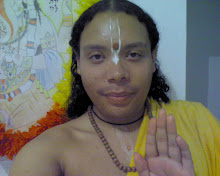




A Hindu Primer
by
Shukavak N. Dasa
Copyright © 2007 Sanskrit Religions Institute
All rights reserved.
Religious Marks: Tilaka/Tika
Going hand in hand with religious denomination (sampradaya) are the religious marks worn by the devotees of the the various schools of Hindu theology. These marks are called tilaka, or in Hindi and many other regional languages, tika. The tilaka is a religious mark worn mainly on the forehead and is made primarily of sandal paste, clay, or ash. The word tilaka is literally a “freckle” or “spot” and it is considered highly auspicious to wear these marks. In general, there are three broad categories of tilaka marks, those worn by Vaishnavas, those worn by Shaivas and general marks. Tilaka marks are made with white, red, yellow or black colors. Vaishnava marks run vertically on the body and Shaiva marks run horizontally. The Vaishnava tilaka is the most extensive. A trained observer can tell exactly which school of theology a devotee is coming from by the color and shape of these tilaka marks. It is fun to visit a traditional holy place of pilgrimage during festival season to watch the holy men and try to read their tilaka and determine which sampradaya they are representing.
Shaiva Marks
Shaiva Tilaka
In general Shaiva tilaka is made of ash coming from burned wood, cow dung or incense. The tradition of ash goes back to stories that tell how Shiva would smear his body with ash taken from cremation sites, and so today, Shaivas mark their bodies with holy ash. In general, amongst Shaivas, the wearing of tilaka is not as extensive or as rigid as it is in the Vaishnava schools. Here are the most common Shaiva patterns. See the illustrations.
Vaishnava Marks
Shri Vaishnava Tilaka
By far the Vaishnava tilaka is the most extensive. Each school of theology, including all the sub-sects, have their own configurations. See the illustrations. In the modern world the wearing of tilaka was two functions, general religious identification and personal sanctification. Nowadays, the need to distinguish sectarian differences is no longer relevant. Amongst the Vaishnavas there was a time when it was considered “sinful” to wear Shaiva tilaka or to even see it. In the past the different schools of theology aggressively debated with each other over the correctness of doctrine and so, like a sports team today, the tilaka was used to identify which school the debater was representing. At one time Madhva Vaishnavas were antagonistic toward Advaita Vedanta Shaivas. Shaiva kings hunted down and even persecuted Shri Vaishnavas. Shaivas would not enter Vaishnava temples and Vaishnavas would not go near Shaiva shrines. But today such sectarian differences hardly exist, and so we see both Shaiva and Vaishnava shrines within the same temple. The function of tilaka has changed greatly. In the West only priests generally wear tilaka and consequently the main function of tilaka is to distinguish a priest from the lay community. This function is similar to how a male Christian priest may wear a collar to distinguish himself from his congregation.
The other function of tilaka is for personal sanctification. Tilaka is generally applied to the body in twelve places (the number varies) after bathing. These places include the forehead, the throat, the heart, the stomach, two shoulders, arms, and so on. Each time a mark is applied, the name of a particular Deity is recited. This touching, marking, and evocation has the effect of personal sanctification. A priest is dedicating his body as a temple of God by applying tilaka.
General Tilaka
Apart from the formal tilaka worn by priests, during a puja generally a simple form of tilaka will be applied to all lay members. This is the application of the so-called "dot" or red mark that is applied during puja or when attending temple. We often explain this by saying that God has given us two eyes for seeing the physical world, the red dot tika is a symbolic third eye or soul’s eye for seeing spiritual reality. During puja someone will often go around amongst the participants and give them tika. This function is akin to “logging in” to the puja, in other words, marking oneself as a faithful participant in the puja.

Nenhum comentário:
Postar um comentário